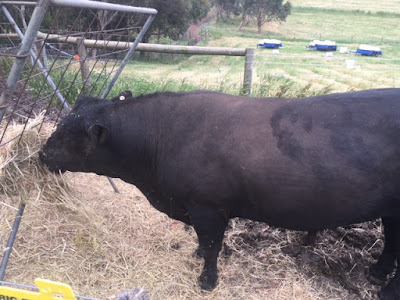A part of our philosophy is to re-use and make do with what we have here on the property.
Making our own fertilizers is one of the most important things that we do here and are fortunate to have all of the ingredients for the best plant foods that we could ever want.
You will never see bags of manure placed outside our gate for sale. Oh no, the only manure that leaves this property would be inside a living animal.
But for the home gardener, without cows, horses or chooks, the bags of manure on the side of the road are a necessary purchase to boost your compost heap.
The manure that the cows drop out in the paddocks is quickly broken down by dung beetles which is another advantage of not using chemicals or wormers. The manure that I collect for composting is from around the hay rack.
Any animal manure (cow, chicken, horse, pigeon) can be put into a pile with chopped up garden cuttings, leaves, kitchen scraps, shredded newspaper, lawn clippings etc to make a better compost than money could buy.
You don't need fancy compost bins; a few pieces of corrugated iron or old pallets, open at the front will do.
Or a round of wire netting to hold all of the ingredients together is just as good. The pile needs to be at least a metre wide to allow the heat to develop, a bit of moisture to get the action started, a bit of a turn with a fork occasionally helps it to break down evenly and faster, but is not absolutely essential.
It's always a good idea to add a bit of your compost from a previous batch to the new pile. You can either spread in a handful as you build up your layers, or poke a few holes into your existing pile and throw some in. There are compost starter preps available to purchase from
Bio-dynamics Association of Australia if you really want to get things going cosmically, but the inoculation -just like making yogurt ;-) - works for me.
Regular additions from your wee bucket is another way of boosting the nutrition level of your compost.
You don't have a wee bucket??
Have you got a semi private area in your back yard? There you can place your wee bucket with a piece of old fabric for a "wee wipe". Dilute the wee by filling the bucket with water every day before tipping onto the compost heap or pour onto the soil around your plants and fruit trees.
Don't do this if you are taking pharmaceutical medications or anti-biotics though.
Replace your wee wipe daily, popping the used one in the washing cycle, and hang on the line to dry with your washing.
Liquid compost and weed tea ferments are another wonderful way to feed your garden. You will need a bucket with a loose fitting lid or a bigger barrel with something to cover it, depending on the size of your garden. It's a good idea to have two compost heaps and two liquid compost barrels, so that you can use one for your garden or pots while the other is in it's breaking down or fermenting stage.
Comfrey leaves are an essential ingredient in both my compost heaps and in my liquid compost tea.
And nettles!! Spring time is when I harvest the nettles growing wild around the garden, for making my brews.
Into this brew I added some chicken manure from the hen's shed, to nettles and comfrey, filled the barrel with rain water and put the lid on. I give it a stir with a long stick every day or whenever I think of it, and it will be ready to use in a month or two.
When it's ready to use, first give it a quick stir, then bucket out a small amount into a watering can, approximately to the ratio of making a glass of cordial, or slightly less. It's quite strong, so always use less rather than too much.
*Brian also uses these brews in his soil activator, adding bio-dynamics (prep500 and 501) to the mix before the stirring phase in the
Flow Form but for the small gardener,
hand stirring in a barrel is just as effective. This is spread out over our paddocks using the quad bike with a spray system attached, but for our gardens we use a spray pump or a watering can.*
Use the fermented tea brews as a weak mixture in pot plants, around fruit trees, vegetables, flowering plants and vines.
This is also good as a foliage feed, but I would suggest using a weaker dilution, and don't foliar feed on a day above 23C degrees as the leaves could burn.
If you don't have the biodynamic preps or the stirrers, I'm certain that you would still get very good results from using the brewed liquid compost teas.
I've been foliar feeding the fruit trees that had been attacked by earwigs as the new leaves were forming and I can't believe the difference. New leaves have formed to the point where no earwig damage is evident at all.
Shane Joyce's words are ringing in my ears, "Manage for what you want, not for what you don't want." Well if ever there is an example of just how that approach does work, this is it.
By building up the strength of the plant, it enables it (the plant) to withstand the attacks of predators. In previous years I've focused on getting rid of the earwigs and have used up a lot of my energy in doing so, but this is working for me now and I have energy to use in other areas.
Sometimes we need to think outside the square.

















































